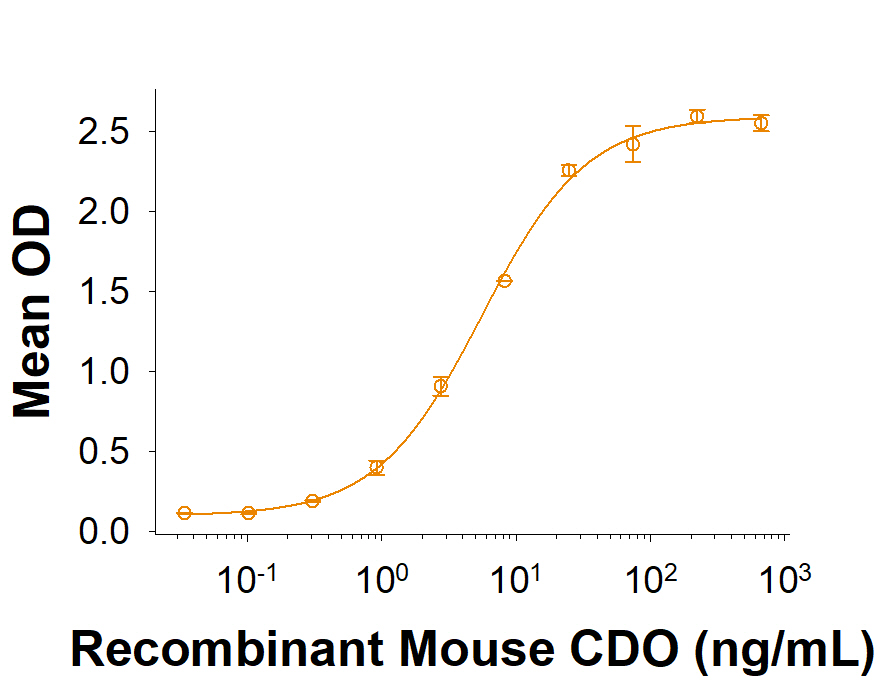Recombinant Mouse CDO His-tag Protein, CF Summary
Product Specifications
Asp25-Tyr962, with a C-terminal 6-His tag
Analysis
Product Datasheets
Carrier Free
CF stands for Carrier Free (CF). We typically add Bovine Serum Albumin (BSA) as a carrier protein to our recombinant proteins. Adding a carrier protein enhances protein stability, increases shelf-life, and allows the recombinant protein to be stored at a more dilute concentration. The carrier free version does not contain BSA.
In general, we advise purchasing the recombinant protein with BSA for use in cell or tissue culture, or as an ELISA standard. In contrast, the carrier free protein is recommended for applications, in which the presence of BSA could interfere.
10505-CD
| Formulation | Lyophilized from a 0.2 μm filtered solution in PBS. |
| Reconstitution | Reconstitute at 500 μg/mL in PBS. |
| Shipping | The product is shipped at ambient temperature. Upon receipt, store it immediately at the temperature recommended below. |
| Stability & Storage: | Use a manual defrost freezer and avoid repeated freeze-thaw cycles.
|
Scientific Data
 View Larger
View Larger
When Recombinant Mouse Sonic Hedgehog/Shh (C25II) N-Terminus (464-SH) is immobilized at 4 µg/mL (100 µL/well), Recombinant Mouse CDO His-tag (Catalog # 10505-CD) binds with an ED50 of 0.8-8 ng/mL.
 View Larger
View Larger
2 μg/lane of Recombinant Mouse CDO His-tag Protein (10505-CD) was resolved with SDS-PAGE under reducing (R) and non-reducing (NR) conditions and visualized by Coomassie® Blue staining, showing bands at 113-135 kDa.
Reconstitution Calculator
Background: CDO
CAM-related/down-regulated by oncogene (CDO), also known as CDON is a member of the Ig/Fibronectin (FN) type III repeat family within the Ig superfamily. Mouse CDO is a type I transmembrane protein, consisting of a large extracellular domain (ECD), a transmembrane segment and a cytoplasmic region. The ECD contains five C2-type Ig-like domains, followed by three FN type III repeats (1). The first FN repeat is known to bind numerous cadherins, while the third (or juxtramembrane) FN type III repeat binds SHH (2, 3). The mature ECD of mouse CDO shares 85% amino acid identity to the ECD of human CDO. CDO is found on muscle precursor and neural progenitor cells of the embryo (4-6). It likely promotes muscle differentiation and contributes to axon guidance and neuronal patterning by signaling through various bHLH transcription factors (2, 5). These effects may be mediated through two different receptor complexes. On muscle precursors, CDO apparently acts as both a coordinating and signaling subunit. Here, it integrates N- and M-cadherin, neogenin, netrin-3 and BOC into a cis-oriented receptor complex (4, 7). While this complex has no identified ligand, intercellular cadherin interactions or netrin, may be enough to trigger CDO/cadherin/neogenin signaling. On axons, CDO may participate in a poorly-defined receptor complex minimally composed of CDO, BOC and Gas1 that binds SHH, and interacts with PTCH1 (8-10).
- Kang, J.S. et al. (1997) J. Cell Biol. 138:203.
- Yao, S. et al. (2006) Cell 125:343.
- Kang, J-S. et al. (2003) Proc. Natl. Acad. Sci. USA 100:3989.
- Kang, J-S. et al. (2002) EMBO J. 21:114.
- Zhang, W. et al. (2006) Mol. Cell. Biol. 26:3764.
- Krauss, R.S. et al. (2005) J. Cell Sci. 118:2355.
- Kang, J-S. et al. (2004) J. Cell. Biol. 167:493.
- Okada, A. et al. (2006) Nature 444:369.
- Allen, B.L. et al. (2007) Genes Dev. 21:1244.
- Tenzen, T. et al. (2006) Dev. Cell 10:647.
FAQs
No product specific FAQs exist for this product, however you may
View all Proteins and Enzyme FAQsReviews for Recombinant Mouse CDO His-tag Protein, CF
There are currently no reviews for this product. Be the first to review Recombinant Mouse CDO His-tag Protein, CF and earn rewards!
Have you used Recombinant Mouse CDO His-tag Protein, CF?
Submit a review and receive an Amazon gift card.
$25/€18/£15/$25CAN/¥75 Yuan/¥1250 Yen for a review with an image
$10/€7/£6/$10 CAD/¥70 Yuan/¥1110 Yen for a review without an image
